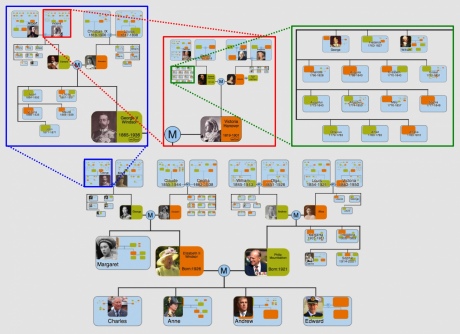People can explore their detailed family tree and grow its branches by sharing information with relatives, thanks to new interactive website ZoomPast.
After researching their family histories, people are often left with sprawling family trees that are difficult to visualise and share. The new website, ZoomPast, solves this problem by allowing huge and complex genealogies to be explored using an innovative zooming interface, similar to an interactive map.
Family trees easily grow too large for printing; at least you would need a lot of sticky tape to join the pages. ZoomPast solves this by automatically generating a huge digital view of your family tree.
– Dr James Rosindell
The family trees of famous and fictional people can also be explored on the site, from Queen Elizabeth II and George Washington to Harry Potter. Genealogies can be viewed from the perspective of any person in a given tree, and a built-in social and sharing platform allows trees to be shared and grown collaboratively or kept completely private.
ZoomPast was created by Imperial College London researcher Dr James Rosindell and his former student Kai Zhong, who is now a software developer. Dr Rosindell, from the Department of Life Sciences at Imperial, said: “Family trees easily grow too large for printing; at least you would need a lot of sticky tape to join the pages. ZoomPast solves this by automatically generating a huge digital view of your family tree that you can then explore just by zooming, as you would a digital map. This is something that truly moves beyond the old paper-based way of thinking”.
ZoomPast places a chosen individual in the centre of the visualisation with all their relatives placed around them. Close relatives are shown as large features easy to see whilst more distant relatives are tiny points. A user can then scroll and zoom into any branch of the family tree to reveal further details in the same way as they might explore Google Earth.
Trees can be built by experienced genealogists or budding family historians. Those with only a few records or memories can watch simple tutorial videos on the website to help them start to build their tree, or more experienced genealogists can upload files they already have from other genealogy software. ZoomPast then creates a digital ‘painting’ that can be explored, including each person’s location and date of birth and death, details of their marriages, photo, jobs and more.
 Queen Elizabeth II's family tree, demonstrating the zooming principle.
Queen Elizabeth II's family tree, demonstrating the zooming principle.
The trees of some historical figures are pre-loaded onto the site, so users can discover, for example, how Presidents Barack Obama and George W. Bush are related as ninth cousins twice removed. From the starting point of one individual, the relationship to another can be visualised by ‘flying through’ to their place on the tree, passing through all the connected branches on the way.
Dr Rosindell hopes ZoomPast will be used not only to help people connect with their own past, but as a tool for outreach and teaching through the wealth of information attached to any individual and the intuitive way it can be explored.
Family challenges
ZoomPast is built on the framework of Dr Rosindell’s previous project OneZoom, an interactive map of the evolutionary tree of life. But while the foundation was there, this new project had its own challenges. “The tree of life shows individual species splitting into several new species, whereas genealogies are more complex” he said. “In family trees there are two parents, multiple siblings and potentially several marriages that complicate the structure.”
There are also ‘loops’ in some family trees. For example, where distant cousins marry each other or two brothers marry two sisters, each individual would appear on the same tree multiple times. In a traditional paper-based system where space cannot be wasted this provides a problem, but in a digital world any person can be repeated multiple times to create seamless linkages.
Dr Rosindell is already thinking about the next subjects that could be added to the ZoomPast, such as the records of pedigree dogs, horses or other domesticated animals, which are important to avoid excessive inbreeding.
Dr Rosindell and Kai Zhong both received funding from NERC for the OneZoom and ZoomPast projects.
A special version of the software used for OneZoom and ZoomPast developed for museums and other public educational venues is available from Imperial Innovations.
Supporters

Article text (excluding photos or graphics) available under an Attribution-NonCommercial-ShareAlike Creative Commons license.
Photos and graphics subject to third party copyright used with permission or © Imperial College London.
Reporters
Hayley Dunning
Communications Division

Contact details
Tel: +44 (0)20 7594 2412
Email: h.dunning@imperial.ac.uk
Show all stories by this author
Martin Sayers
Communications Division

Contact details
Tel: +44 (0)20 7594 8140
Email: m.sayers@imperial.ac.uk
Show all stories by this author
Leave a comment
Your comment may be published, displaying your name as you provide it, unless you request otherwise. Your contact details will never be published.




Comments
Comments are loading...